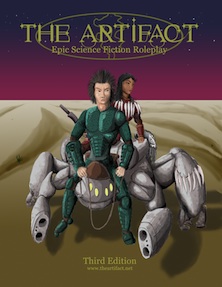Chainsaw Aardvark over at 1KM1KT has proposed a design challenge on how to make a RPG mechanics so that play centers around stealth. It’s a good thought experiment because there’s something wrong with using stealth in most games.
My players have lamented that they try to operate in a stealthy way but as soon as they fail a roll, they’ve given themselves away and are now going to have to rely on more explosions to get through the rest of their mission. If anything, stealth only holds off the devastation and they reason, “Why try? Let’s stick with what we’re good at.”
This is actually very telling. It means that the players perceive that they cannot actually use stealth as an effective strategy.
Why is this? What the players are recognizing is that this is a save or fail situation. Save or fail situations are exciting in small doses but are not fun when prolonged for more than a handful of turns.
For example, I could model combat by saying you get to roll for your defense but if that fails you roll vs your Constitution. If you make your roll, you live. If you fail you die. This may be an accurate way to model wounding but it’s also not fun. Statistically the system might be designed to give the PCs exactly the same life expectancy as a hit point system but the first time the group’s tank drops on the first roll, the players will loose faith.
This is essentially what happens when trying to sneak around. Sometimes the players sneak around for a dozen turns and it all works out. Other times the player flubs a roll on the first turn. The players lose faith in their ability to use stealth.
The first thought is have some kind of Stealth Points like Hit Points. I don’t particularly like that solution for games in general because it’s a limited use stat to track. Some characters would use it all the time while others would never use it at all. Then it sits on the character sheet taking up space. If it was the core of the game, yes, it would be fine.
Advanced Stealth Rules For The Artifact
The Artifact has several skills that could play into stealth rolls, so let’s look at what could be done to tie them together into a more robust stealth system.
Preparation
A character can roll on their Surveillance skill and store the fractional successes for sneaking around. This surveillance effort can be made by the same character that’s doing the sneaking around or by another character communicating with the character doing the sneaking.
Rolling multiple times does not add Fractional Successes to the total but higher roll results replace lower results. The character doing the surveillance can roll as many times as needed to get the desired result but each roll takes 15 minutes of time.
Camouflage skill rolls can also be used to disguise the character doing the sneaking. This can be used in addition to the Surveillance Fractional Successes. Each Camouflage roll takes 15 minutes of work and may include disguises.
Execution
The character sneaking around uses the Stealth skill as normal but may spend Fractional Successes on failed rolls or to bolster rolls. As the Fractional Successes are used up, it represents the characters that the PC is trying to sneak past growing suspicious or becoming more alert to the PC’s presence.
Recovery
At a certain point the character sneaking around may need to recover points that have been spent. To do this, the character rolls against their Hide skill. This represents the character laying low and doing things that are not suspicious. For example, if a character is disguised as a janitor, they’d spend time mopping the floor. If they’re disguised as an office worker, they’d find a place to look like they’re acting as an office worker should. It also might include hiding in the broom closet for an hour or so if that’s needed.
As the character rolls for their Hide skill, they regenerate the successes that were stored up for Surveillance and Camouflage.
What do you think?


 The Free RPG Blog
The Free RPG Blog
Stealth should be a skill contest (hiding person vs observers). Modifiers based on circumstances – an army base guard will pay more attention to something strange than a random person on the streets. Definitely give out bonus/penalty based on what the players’ strategy is. Equipment plays a big role too – for example an IR sensor means you won’t be able to hide, really.
Also, do research. One thing that comes to mind was a mythbusters episode in which Adam and Jamie attempted to disguise as each other and tested whether they could fool their crew and volunteers. It was quite interesting.